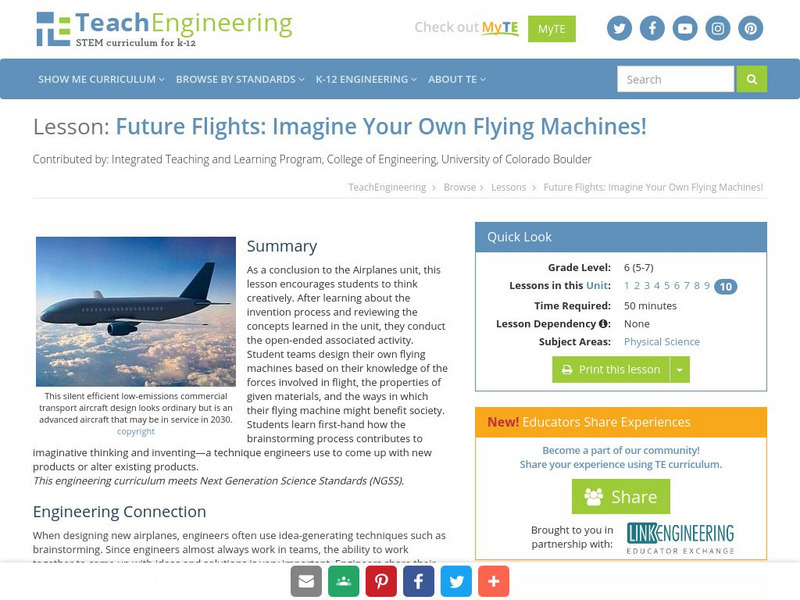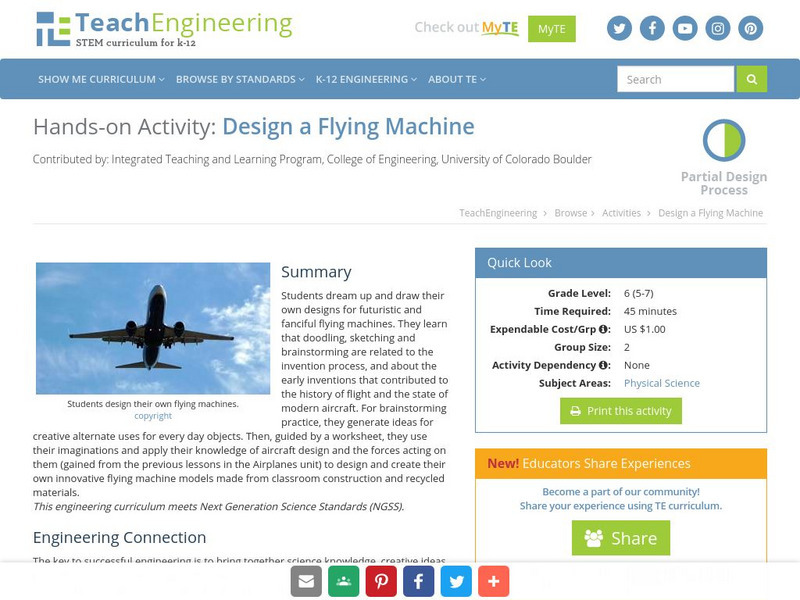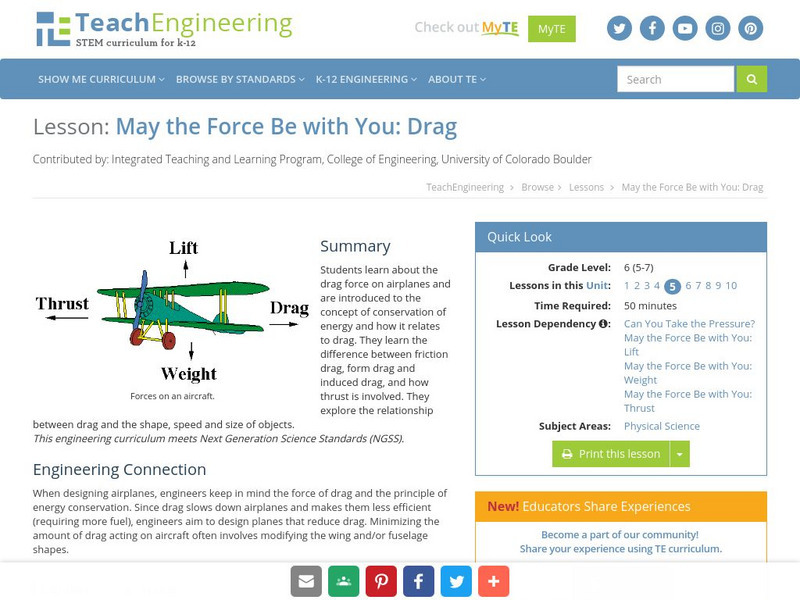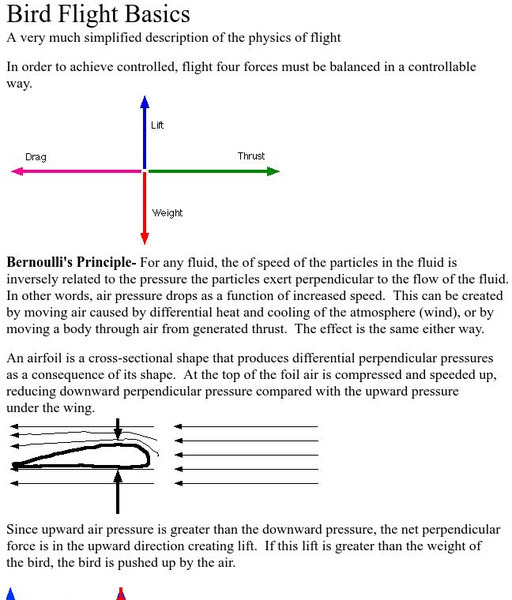Children's Museum
The Children's Museum of Indianapolis: Curious Scientific Investigators: Flight Adventures
Students will make paper rockets, parachutes, and foam gliders to experience how objects move through the air. Explore topics such as thrust, weight, gravity, force, and lift through fun activities and stories and cutting-edge work done...
PBS
Pbs Learning Media: Centripetal Force: Pulling Cs and Gs
In this interactive activity from NOVA, discover how centripetal force can affect you when riding in a car or flying at high speeds in a fighter jet.
Smithsonian Institution
Smithsonian Learning Lab: How Things Fly: Activities for Teaching Flight
Through this series of three lessons, students will gain an understanding of the basics of flight. They will learn about the four forces of flight and practice their observation skills through a number of fun experiments. In addition,...
TeachEngineering
Teach Engineering: Future Flights!
This lesson is an exciting conclusion to the airplanes unit that encourages young scholars to think creatively. After a review of the concepts learned, students will design their own flying machine based on their knowledge of the forces...
TeachEngineering
Teach Engineering: Design a Flying Machine
The purpose of this activity is for the students to draw a design for their own flying machine. They will apply their knowledge of aircraft design and the forces acting on them. The students will start with a brainstorming activity where...
TeachEngineering
Teach Engineering: May the Force Be With You: Drag
This lesson plan explores the drag force on airplanes. The students will be introduced to the concept of conservation of energy and how it relates to drag. Students will explore the relationship between drag and the shape, speed and size...
NASA
Nasa: Weight and Balance Forces Acting on an Airplane
The effects of forces exerted on an airplane wing are discussed both conceptually and mathematically. Illustrations and sample problems and solutions are provided.
TeachEngineering
Teach Engineering: What Makes Airplanes Fly?
Learners begin to explore the idea of a force. To further their understanding of drag, gravity and weight, they conduct activities that model the behavior of parachutes and helicopters. An associated literacy activity engages the class...
A&E Television
History.com: Miracle of the Andes: How Survivors of the Flight Disaster Struggled to Stay Alive
When an Uruguayan rugby team crashed in the Andes on Friday, October 13, 1972, cannibalism helped some survive two months in harsh conditions. The Uruguayan Air Force Fairchild F-227 had crashed into a glacial valley high in the Andes....
South Carolina Educational Television
Etv: Nasa Online: Flight: Thrust
An introduction to thrust and how it relates to airplanes, told in an animated format.
Other
Spacefilght Now: Air Force Imagery Confirms Columbia Wing Damaged
A detailed article from February, 2003, which discusses Air Force photos that show that there was damage to a wing of the Space Shuttle Columbia. The article also recounts the last few moments aboard the Space Shuttle Columbia before its...
TeachEngineering
Teach Engineering: May the Force Be With You: Lift
Students revisit Bernoulli's Principle (Lesson 1 of the Airplanes unit) and learn how engineers use this principle to design airplane wings. Airplane wings create lift by changing the pressure of the air around it. This is the first of...
Smithsonian Institution
National Air and Space Museum: Wright Brothers: Interactive Experiments
Three interactives in an online exhibition about the Wright Brothers. The first is an engineering activity on the forces of flight, and is accompanied by a lesson plan for Grades 6-8. The second is a gallery of original artifacts related...
TeachEngineering
Teach Engineering: Up, Up and Away! Airplanes
The airplanes unit begins with a lesson on how airplanes create lift, which involves a discussion of air pressure and how wings use Bernoulli's Principle to change air pressure. Following the lessons on lift, students explore the other...
Science Buddies
Science Buddies: Two Stage Balloon Rocket
Students will build a multi-stage balloon rocket that they can launch across the classroom while learning about real space flight and Newton's laws of motion.
TryEngineering
Try Engineering: Designing Drones
This lesson focuses on helicopters and drones, how they fly, how they are used in different ways that help people and the environment. Teams of students explore helicopter flight; and design, build, and test their own simple rotor out of...
Other
Pacifier Online: Bird Flight Basics
This site provides a simplified explanation of the physics of flight. Site provides information about lift, drag, weight, thrust, Bernoulli's Principle, and much more.
TeachEngineering
Teach Engineering: Flying With Style
As students begin to understand the physics behind thrust, drag, and gravity and how these relate these to Newton's three laws of motion, groups assemble and launch the rockets that they designed in the associated lesson.
TeachEngineering
Teach Engineering: Physics of the Flying T Shirt
Students are introduced to the physics concepts of air resistance and launch angle as they apply to catapults. This includes the basic concepts of position, velocity and acceleration and their relationships to one another. They use...
PBS
Pbs Teachers: Flying High: Taking to the Air
Explore the science of surface tension, the evolution of flight in insects and insects' anatomical adaptations. Construct insect models that illustrate the action of these adaptations and calculate the force per unit area of water surface.
PBS
Pbs: Nova: Top Gun Over Moscow
An online exhibit investigating the sensations experienced by a cockpit pilot in a Russian aircraft. Focuses on G-forces and apparent weightlessness.
South Carolina Educational Television
Know It All: Lift | Nasa Online
An upward force called lift acts on the airplane and opposes the downward forces of gravity. The lift force allows the airplane to get off the ground and stay in the air. Watch the simulation to see how this works.
BioEd Online
Bio Ed Online: Balloon Blast
In the following instructional activity students are asked to devise a plan to measure the distance of a balloon's flight, predict the direction a balloon will travel as it deflates, learn about Newton's Laws of Motion, experience...
TeachEngineering
Teach Engineering: Will It Fly?
In this instructional activity, students will learn about kites and gliders and how these models can help in understanding the concept of flight. Students will design and build their own balsa wood models and experiment with different...
Other popular searches
- Forces of Flight
- Four Forces of Flight
- 4 Forces of Flight
- Forces of Flight Gravity
- Forces of Flight Weight
- $ Forces of Flight
















